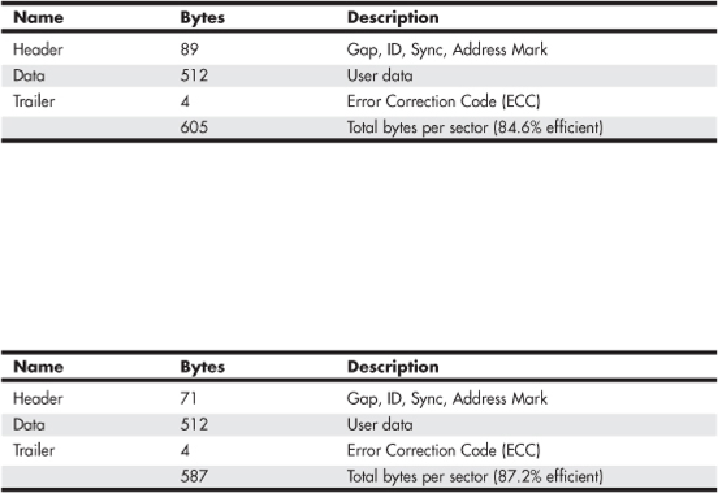Hardware Reference
In-Depth Information
of each sector as possible can be used for storing user data. The ratio of the user data in
a sector to the total number of bytes physically used by the sector on the disk denotes the
sector efficiency. The way tracks and sectors have been formatted over the years has al-
lowed efficiency to improve, but only up to a point.
The sector format on a given drive is dictated by the controller, which was originally a
separate entity from the drive. One of the first hard disk controllers used in PCs was the
Xebec1210,theHDDcontrollerusedinthevintage1983-1987IBMXT.
Table9.2
shows
thesectorformatcreatedbytheXebec1210/1220controllers.(The1220hadanintegrated
floppy controller.)
Table 9.2 Xebec 1210/1220 (IBM XT) 512-Byte Sector Format
As you can see from the table, drives formatted using those controllers had sectors that
stored 512 bytes of user data yet consumed 605 total bytes on the disk, for a sector effi-
ciency of 84.6%. Later controllers were able to increase format efficiency by reducing the
size of the gap and other information in the header. For example,
Table 9.3
shows the sec-
tor format created by the Western Digital WD1003 and WD1006 controllers used in the
vintage 1984-1987 IBM AT.
Table 9.3 Western Digital WD1003/WD1006 (IBM AT) 512-Byte Sector Format
These controllers created 512-byte sectors that consumed 587 total bytes on the disk, for
an improved sector efficiency of 87.2%. After 1987, the AT disk controller became part
of the drive, which is what we call the ATA interface, often also referred to as IDE (In-
tegrated Drive Electronics). Integrated controllers allowed much tighter signal timing and
speed, allowing for more sectors to be stored on each track and for additional improve-
ments in sector efficiency.

